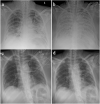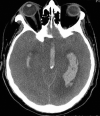Extracorporeal membrane oxygenation (ECMO) in COVID-19 patients: a pocket guide for radiologists
- PMID: 35279765
- PMCID: PMC8918086
- DOI: 10.1007/s11547-022-01473-w
Extracorporeal membrane oxygenation (ECMO) in COVID-19 patients: a pocket guide for radiologists
Abstract
During the coronavirus disease 19 (COVID-19) pandemic, extracorporeal membrane oxygenation (ECMO) has been proposed as a possible therapy for COVID-19 patients with acute respiratory distress syndrome. This pictorial review is intended to provide radiologists with up-to-date information regarding different types of ECMO devices, correct placement of ECMO cannulae, and imaging features of potential complications and disease evolution in COVID-19 patients treated with ECMO, which is essential for a correct interpretation of diagnostic imaging, so as to guide proper patient management.
Keywords: Acute respiratory distress syndrome (ARDS); Computed tomography; Coronavirus disease 19 (COVID-19); Extracorporeal membrane oxygenation (ECMO); Severe acute respiratory syndrome coronavirus 2 (SARS-CoV-2); X-ray.
© 2022. The Author(s).
Conflict of interest statement
The authors declare that they have no competing interest.
Figures









References
Publication types
MeSH terms
LinkOut - more resources
Full Text Sources
Medical
Miscellaneous

